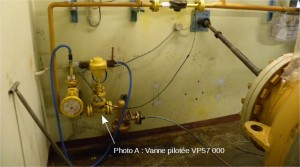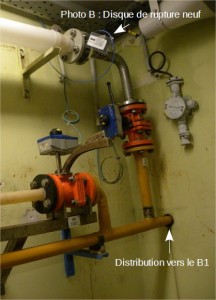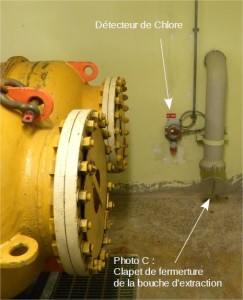A chlorine leak occurred at around 1:50 a.m. in a chemical plant that manufactures contrast agents for scanners. In the production building, an operator wanted to open the storage and distribution facility’s manual chlorine inlet valve in order to introduce chlorine into a process. He mistakenly opened the manual valve located just next to it, letting nitrogen enter the chlorine line. According to the operator, this is possible only during maintenance operations on the chlorine distribution system since the valve rod is removed. However, although no maintenance operation was underway, the valve rod was still in place. Moreover, the pressure regulator on the nitrogen system, generally set at 2.9 bar, was set at 4 bar. The influx of nitrogen created an overpressure exceeding 4 bar in the chlorine system, causing the rupture disc, set at 2.9 bar, to burst. According to the operator’s calculations, approximately 175 g of chlorine was released into the atmosphere. At 1:50 a.m., the chlorine detection alarm, relayed to the production technician’s phone, indicated a chlorine concentration above 10 ppm in the facility.
This detection arrangement involves closing the externally-operated valve, isolating the chlorine tank from the distribution system and starting the system to extract the atmosphere from the room. At 1:52 a.m., the technician actuated the handwheel-operated valve located on the outside of the distribution room, thereby allowing the chlorine tank valve supplying the system to be closed. At 2 a.m., a first two-man team, wearing protective suits, entered the room, checked that the scrubbing column was operating correctly, closed an additional manual valve on the distribution system and placed the absorption system in forced operation. The in-house first responders set up a water curtain around the building to suppress a possible chlorine gas cloud. Measurements indicated zero chlorine levels at the site’s property limit. Three employees reported feeling nauseous at around 2:30 a.m. and were then taken to the hospital by the firefighters and then released at 9:30 a.m. The emergency services left the premises at 7 a.m.
The operator took the following initial steps: verification and adjustment of the pressure regulator at 2.9 bar, cleaning of the chlorine scrubbing column, padlocks installed on the manual nitrogen valve, and recommissioning of the chlorine detector. A meeting with the Health and Safety Committee was scheduled. The next day, a new rupture disc was installed (calibrated at 3.5 bar), and the operator who had operated the wrong valve was given remedial training in process control. In the days that followed, the operator analysed the risks involving the facilities distributing thionyl chloride and HCl to identify the possible presence of a similar configuration, which is not the case. Consideration is being given to the design of the distribution installation and the interest in maintaining the nitrogen injection line.






